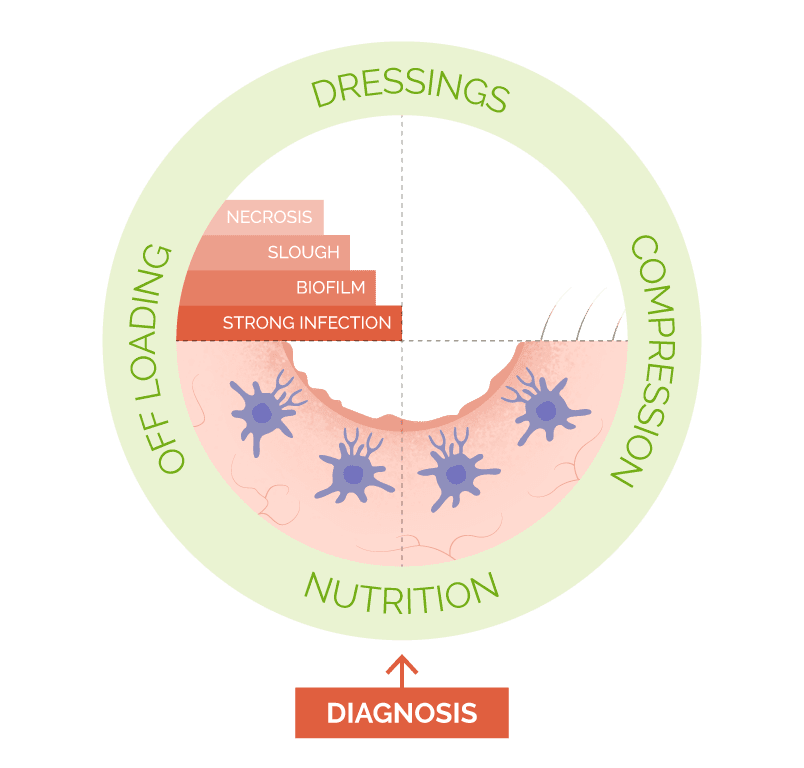Therapy knowledge is essential when selling medical products
Knowledge is essential when selling medical products, knowledge is undoubtedly important when selling new innovative products, and in general, knowledge is vital to gain the respect of healthcare professionals. Therefore, Coopmed divides the sales structures and concepts around therapy areas.
WOUND HEALING
Healing Wounds takes more than just one product
Caring for patients with chronic wounds is a significant challenge, involving professionals at different levels of education, from surgeons to specialized nurses and homecare personnel.
To make the very complex processes of diagnosis and treatment of these patients understandable, different models are available to healthcare professionals.
The T.I.M.E concept (tissue, infection, moisture, edge), published in 2003 and expanded to TIMERS in 2018 (including regeneration of tissue, and social factors), is undoubtedly at the center of attention.
As a guide for local therapy of chronic wounds, Wund-D.A.CH., the umbrella organization of German-speaking wound healing societies, also provided M.O.I.S.T. and presented a new concept for local treatment of chronic wounds.
All these concepts serve to illustrate the highly complex, interdisciplinary process of wound healing and to create a uniform nomenclature for the treatment of these wounds.
The Coopmed wound model is true to these models and very visualizes merely the most critical steps in the care of people with hard-to-heal / chronic wounds.

The keys to effectively healing wounds are well-educated healthcare professionals able to diagnose the wound and patient-related factors like
- Cardiovascular disorders
- Medication (e.g., non-steroidal anti-inflammatory drugs, corticosteroids)
- Obesity
- Microbial colonization of the wound
- Systemic disorders (e.g., diabetes, autoimmune conditions)
- Unrelieved pressure on the wound
- Maceration due to excess wound exudate or other moisture
- Inappropriate wound management
- Patient compliance with the wound care regimen
- Immobility
Based on that diagnosis, nurses will formulate a treatment plan, including indication-specific essential focus options where needed, like offloading for Diabetic Foot Ulcers or compression for Venous Leg Ulcers, not to mention:
- Fighting critical barriers to wound healing such as Necrotic tissue, slough, bacteria, biofilm, viruses, infections, and multidrug resistance organisms
- Accelerating healing of stalled wounds by using active ingredients
Besides, the healthcare professional also needs to pick the right dressing to cover the wound that ensures the proper moisture level at any point in time.
It is a complicated process that needs skilled eyes, which we have tried to visualize and simplify in the Coopmed Wound Model.
Many different products from established manufacturers are already available to clinicians. But as innovation levels within the industry historically are relatively low, CoopMed aims to focus on a portfolio of synergistic innovative products from start-up companies who do not have the resources of large companies.
To improve future healing rates, we believe that you need to focus more on the education of healthcare professionals and Active Wound Healing concepts.
The barriers to wound healing are many
When selecting suitable products for this concept, Coopmed will be supported by a board of clinical consultants made up of international experts from various wound healing-related disciplines.
INCONTINENCE & OSTOMY
Patient issues caused by incontinence complications and ostomy operations are broad spectrum and many
These are homecare-related areas and a focus of Coopmed, with one solution so far. The BlauProtect® Liquid Barrier Film protects the surrounding skin of ostomies and reduces the risk of Incontinence Associated Dermatitis (IAD).
REHABILITATION
Is an important homecare-related area for the Quality of Life of the handicapped. An area that fits into the focus of Coopmed.
CIRCULAR ECONOMY IN HEALTHCARE
Single-use consumables in healthcare are a major waste problem
Millions of non-woven and plastic products are disposed of every day. Some are used in specialized centers and laboratories with high consumption and control. Ideal for circular concepts.
DIAGNOSING & MONITORING
Knowing relevant biomarker numbers, and when and how to react to a patient’s health needs is important, and so is, when not to disturb when there is no need for it.
Improving the sleep of vulnerable elderly at home or in homes makes a huge difference to the individual, which means not disturbing them unnecessarily during the night. At the same time acting when needed, and with the right understanding of the patient’s need for care and treatment is critical. Here affordable eHealth solutions, biomarkers, and devices can help to find the right balance.
HEALTHCARE-ASSOCIATED INFECTIONS
Bacteria, viruses, infections, and multidrug-resistant organisms are a fact of life in healthcare settings
Infection Control is a major and very important focus area of any institution, and within healthcare, it is often referred to as HAI; Hospital-Acquired Infections (or nosocomial infections), meaning infections acquired specifically at the hospital/healthcare setting, or as the slightly broader term Healthcare-Associated Infections. In our model, we have chosen a broader understanding of infections related to healthcare.

Infection Control Management certainly needs to focus on clean hands, gloves, surgical gowns, clean surgical rooms, equipment, and wards – surfaces – clean surgical tools, but also medical devices that hold the risk of transporting bacteria or viruses into the body.
Such a broad focus on cleanliness or even sterile conditions requires a lot from both support products and procedural compliance. It is a discipline of its own.
Many different products from established manufacturers are already available to clinicians but, as innovation levels within the industry historically are relatively low, Coopmed aims to focus on a portfolio of innovative products and support solutions from start-up companies.
To reduce infection levels, we believe that we not only need to focus on new products but also on support tools to improve the compliance of healthcare personnel to infection control procedures.
